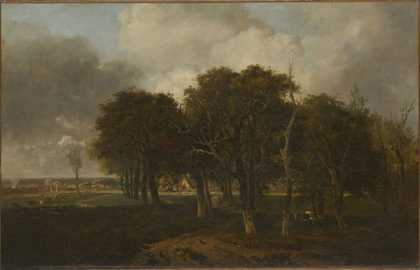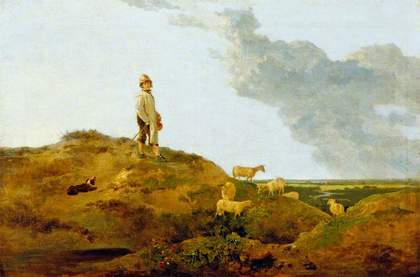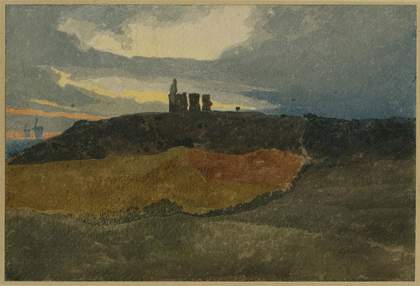When Richard and Samuel Redgrave included John Crome in their history of British art, A Century of Painters of the English School (1866), Crome’s humble origins, lack of education and preference for remaining ‘in a remote angle of the kingdom, seldom visited for its scenery’ were deemed to explain why he had achieved only local fame.1 Nevertheless, the Redgraves were aware that since his death in 1821 Crome’s reputation beyond Norwich had grown apace, and the National Gallery’s recent decision to buy Mousehold Heath, Norwich from a private collection ensured that the painting would be discussed in their book. Their account of it provides a sensitive description of the picture and a tribute to Crome’s abilities:
His picture of ‘Mousehold Heath’ … is a good example of his style. It shows how very little subject has to do in producing a fine picture. A sky, a barren heath spreading away into the far distance, a bank in the foreground, with a few weeds, are all the materials the painter had to treat; but the manner of treating them has resulted in a beautiful work. The sky is very luminous, with grand rolling clouds, accidental shadows from which are thrown over the distance and the foreground, leaving the middle distance luminous, clear and cool, though rich and full of colour. A few thistles and large weeds in the foreground, and some small figures going away into the picture, complete this interesting work; interesting from its painter-like treatment, certainly not from [its] subject.2
The Redgraves’ emphasis on Crome’s style is justified, acknowledging his sound technique and his skill in the representation of landscape, but their insistence on the irrelevance of his subject matter is too assertive. As it is unclear whether or not the picture was exhibited in Crome’s lifetime it is impossible to say precisely what title he may have chosen for it, more specifically whether it would have carried a more generic name without any topographical reference or whether it would have included a subsidiary phrase designed to draw attention to particular attributes of place or time. His practice in this respect was mixed, showing some works with specific topographical titles, such as Scene on Hautbois Common, near Coltishall, Norfolk c.1810, which was exhibited at the Norwich Society of Artists exhibition in 1810 (probably the picture now in the Metropolitan Museum of Art, New York; fig.1), and some with much more general titles, such as Boy Keeping Sheep; Morning c.1812, exhibited there in 1812 and possibly the picture now titled View on Mousehold Heath, Near Norwich in the Victoria and Albert Museum, London (fig.2).

Fig.1
John Crome
Hautbois Common, Norfolk c.1810
Metropolitan Museum of Art, New York

Fig.2
John Crome
View on Mousehold Heath, Near Norwich c.1812
Victoria and Albert Museum, London
The differences between such titles should not be exaggerated, however. Even when providing a specific title Crome always balanced topographical representation with a concentration on texture, light and atmosphere. Similarly, even his pictures with non-specific titles are deeply informed by his understanding of the landscapes with which he was familiar.3 Both of these aspects should be kept in mind when considering Mousehold Heath, Norwich, for despite its skilled control of tone and colour across such a broad expanse of sky and land, and notwithstanding its masterful depiction of evening light, the landscape it depicts is not merely a pretext for the display of painterly prowess. Even if this painting is to be understood as a distillation of experiences on Mousehold Heath, rather than an actual view, it is very much about that specific place: whatever title Crome intended for it, no resident of Norwich would have been unacquainted with what he has depicted here.
Mousehold Heath is a tract of land lying north-east of Norwich, rising high above the city. This plateau has important historical connections: first, for being the place where on 17 June 1381 the army of the Peasants Revolt assembled before assaulting Norwich; and second, for being the most prominent location for Kett’s Rebellion in July 1549, when Robert Kett, leading disaffected peasants who were protesting against the enclosing of common lands and its threat to their livelihoods, set up camp on the heath before attacking Norwich. Both rebellions were defeated, but their histories were well known and the association of the open heath with struggles for liberty had gained ground in the modern era for more progressive thinkers. From a conservative point of view, of course, the rebellions could be characterised as dangerous challenges to the political settlement. But whatever one’s opinions, the heath’s historicity was a factor in its appreciation. One example of a creative response is a poem written in 1802 entitled ‘Lines, Written on Mousehold Hill, near Norwich’ by a certain William Case, with Kett presented in a highly critical light:
Stranger, whose feet this mountain’s sun-burnt steep
Laboring have scaled, if that thou lov’st to muse
On deeds of other days, O may this spot
Arrest thy roving fancy! Know, that erst
Kett, that base recreant to the loyal cause,
Marching his rabble thousands up these heights,
Here pitch’d his wide-spread camp; here grew of yore
That tree, the ‘Oak of Reformation’ named,
Beneath whose hoary boughs the factious chief
Harangued his vile adherents. — Sallying forth
Sudden, he storm’d yon city gates, then pour’d
His bold marauders on the neighbouring towns,
And awed them to subjection. Yet not long
Thus triumphed he — high on yon castle walls
Was hung his chained corse; his colleagues shar’d
The rebel’s doom, and with their carcases
The Oak’s broad branches bow’d. Tho’ o’er the land
Two ages since have roll’d, the name of Kett
Lives in his country’s curse! Such fate be theirs,
Who vaunting, as in scorn, the hallow’d cause
Of Freedom, plot against their Albion’s weal.4
Mousehold Heath, in this respect at least, may be regarded as a landscape whose past was bound up in its present. While some of these events were of national concern, such as the rebellions, others were of local relevance only, but it is important to keep in mind that the heath, for all its bare and boundless spatial character, was to local eyes a site full of rich associations. The so-called Kett’s Castle, a ruined chapel on the heath, was a well-known physical reminder of Robert Kett’s rebellion. Not unnaturally it was chosen as a subject by some of the Norwich School artists and, in so doing, the association between the heath and its historical legacy would have been underlined for the local spectator. One example is John Sell Cotman’s watercolour Kett’s Castle c.1809–10, which was exhibited in the Norwich Society of Artists exhibition of 1810 (fig.3).5

Fig.3
John Sell Cotman
Kett’s Castle, Norwich c.1809–10
Norwich Castle Museum and Art Gallery, Norwich
© Norfolk Museums Service
More generally, this historical resonance is captured in the Norwich Magazine, which published a series of ‘Tales of Mousehold Heath’ in 1835, introducing the first of them with a reminder that for the narrator ‘each heathy knoll and grassy dell presented to his busy imagination the long departed forms that once moved over them … We all knew his feelings … and to a certain extent participated in them.’6 This idea of the heath as a repository of historical reference and local knowledge was a significant part of its appeal for the inhabitants of Norwich.
The original heathland was much bigger than it is today, covering several thousand acres and stretching from Norwich to Woodbastwick, South Walsham and the Norfolk Broads. The land was crossed by several public rights of way and was therefore an environment that many experienced as they moved through it. It was not a prosperous or productive landscape, being used primarily for sheep rearing, as well as offering grazing for cattle, sand and gravel extraction, and marl- and chalk-pits. The herds of cattle and sheep pastured on the heath were well known and not just to Norwich citizens. Anna Barbould’s poem ‘Petition of a Schoolboy to his Father’, probably written between 1774 and 1785 while she was working at the Palgrave Academy in Suffolk some twenty-five miles away, refers to ‘the fairest herds on Mosswold Hill’ as a well-understood point of reference.7
Between 1750 and 1820 the British countryside was transformed by the enclosing of common lands and the ploughing up of heaths to boost their agricultural return. Successive acts of Parliament saw the enclosure of some 6.8 million acres or approximately 20.9 per cent of England.8 This wholesale change in land usage saw marginal communities displaced as their long-accustomed access to pasturage and fuel was denied, and many were immiserated as a result. John Clare’s indignant and politically sensitive denunciation of the process in his poem ‘Remembrances’ (written c.1832) is probably the best-known response to enclosure’s disruption of a time-hallowed way of life and the social calamity it engendered.9 Norfolk was not immune to the enclosure movement and the heathland situated just outside Norwich was, not unexpectedly, an obvious target for improvement. In the 1780s calls were made to enclose Mousehold Heath, many of them by landowners on adjacent properties who wished to extend their existing agricultural holdings or to create new landscape settings for their villas.10
The heath’s unrealised potential was used as a spur to rally support for enclosure. As the art historian Trevor Fawcett has shown, throughout the 1780s and 1790s the possibility of improving it was actively debated in Norwich.11 It might be said without too much exaggeration that the idea of the land not working to its full capacity was the agricultural equivalent of those regular jibes directed at the idle poor. Within the ideology of mercantile capitalism only the hard working, whether land or families, were seen to make a proper contribution to the commonweal. This antagonism to idleness explains the rhetoric deployed to attack Mousehold Heath in the Norwich Mercury of November 1783, which carried a letter describing Mousehold as ‘this disgraceful heath’.12 A pamphlet published in the city in 1792 provides a good indication of the tenor of the argument supporting agricultural improvement and the ‘nuisance’ of heathland. Entitled An Essay on Wastes in general, and on Mosswold in particular, it has been attributed to the Norwich writer the Reverend Henry Kett (1761–1825). Although he argued that those who lost their existing rights of access must receive compensation in the form of allotments, he was nevertheless sure that the heath’s current usage encouraged the idle poor, that enclosure would see an increase in agricultural productivity to the benefit of all and that it was therefore self-evidently the correct course of action to follow.13 In deference to customary uses of Mousehold Heath, Kett was prepared to retain some sheepwalks in the plan for enclosure, as doing so would not greatly impede the proprietors’ endeavours, which he memorably described as intending ‘to circulate the yet stagnant juices of this palsied giant’.14
The first enclosure act for Mousehold Heath was passed in 1799, with subsequent acts in 1800 and 1801 resulting in the bulk of the heath becoming enclosed and its agriculture ‘improved’ by around 1814. The physical transformation and reduction of Mousehold Heath can be perceived by comparing how it appears in two surveys: William Faden’s map of Norfolk, published in 1797, and Andrew Bryant’s of 1826.15 What remained of the heathland in its original and unenclosed state was the area closest to the city, above the hamlet of Pockthorpe. This portion of Mousehold Heath was still a sizeable tract of land, approximately 184 acres in extent, but it was obviously much diminished from what it had been before the turn of the century and so offered a very different experience to those who could remember the original vast expanse of open country that had once been Mousehold Heath’s domain. This included, of course, anyone of Crome’s generation, who were in their thirties when the enclosing of the heathland began.
Those who had the most to lose from the enclosing of Mousehold Heath, namely the rural poor who relied on it for sustenance and support, have left no record of their feelings and it might be supposed that only they would have protested at its loss. However, the heathland also appealed to many precisely because it had for so long been an integral part of the local landscape and in its untouched state offered the possibility of recreation away from the city and, for some, deep communion with nature. Even among the well-educated classes, and irrespective of the rational case for improved agricultural yields, not everyone was convinced that Mousehold Heath’s transformation should be welcomed without regret. A poem entitled ‘On the inclosure of Moswold, otherwise Mousehold Heath’, published in a Norwich newspaper in 1803, begins unambiguously as an elegy for that lost landscape, before acquiescing in the blessings of its improved agricultural production:
SWEET MOSWOLD! And are all thy charms no more,
The fragrant thyme, the lightly-pendant bell?
The gentle slope, the level lawn before,
And the green hillocks that I loved so well?The flowering heath, that purpled to the view,
Far as the eye could ken the verdant scene;
The bank that half concealed the violet blue,
The rude thorn standing lonely on the green.Oft have I seen the wild and prickly broom,
Profusely gay, its yellow blossoms spread;
But now its glowing hues no longer bloom,
Its beauties faded, and its honors fled.Where erst the molehill clad with yielding moss,
Allured the roving pilgrim to its seat;
The ruthless spade has dug the deepened fosse,
And raised the rampart-fence before his feet.Where the soft turf obeyed the passing tread,
And grass luxuriant waved to downy sleep;
Spread the brown field the rustic share has made,
The clod unbroken, and the furrow deep.Tho’ many an upturned daisy wakes our grief,
And many a green blade, in its youth that dies;
Another spring shall kindly bring relief,
Another autumn bid its harvest rise.Methinks I see behind the veil of years,
The farm-house neatly thatched, the dairy white,
The barn’s long loop, that shews the pressing ears,
And the trimmed stack, whose sweets so far invite.To the warm south a little spot is chose
For savory herbs and vegetable store:
Here shall the perfum’d bean its scent disclose,
And the light pea flaunt gaily to the show’r.Fair hill! I mourn thy gently-waving brow,
Thy prospects hidden, and thy levelled plain;
Yet still I love to view the sun-burnt glow,
That tells the labors of the cheerful swain.I love to listen to the harvest throng,
The wagon team slow moving on with corn;
The softer accents of the gleaner’s song,
And sound of sickle at the hour of morn.Then let us to the hand of Culture yield
The barren beauty of the dusty plain;
Forget the wild heath in the fruitful field,
And welcome Harvest to his golden reign.16
The poem’s appearance probably stimulated the letter that appeared in the same newspaper a week later bemoaning what enclosure had done to the heath, which had formerly offered a place of recreation, healthy air and natural beauty, and lamenting that the citizens of Norwich had not thought to preserve at least the portion closest to the city for the benefit of its inhabitants.17 The following week a poem was published on Kett’s Castle, describing how enclosure had affected access to the ruin, which might now be threatened with destruction and live on only in memory:
When summer suns prolong’d the happy day.
How, round this wall, near which the cattle browse,
The infant train enjoy’d their pastimes gay,
For every schoolboy well Kett’s castle knows.But now usurp’d by Interest’s sturdy claim,
The public walk becomes a cultur’d field;
And thrown at distance by the rural reign,
Kett’s mouldering ruin now we’re forced to yield.Yet if a near approach must be deny’d,
Let not that wall by ruthless hand be ras’d!
For to its form, has Mem’ry oft allied
Pleasing ideas, by Time’s hand effac’d.18
Other writers continued to draw attention to the way enclosure had altered the local landscape, relying on the fact that among their readers the unenclosed heath was a memory that many shared. One example is the aforementioned account of Mousehold Heath presented in the Norwich Magazine in 1835, which is introduced via a retrospective glance to the author’s boyhood, before reminding its readers that on his return to Norwich he had found the rural scenes he once knew transformed: ‘During the interval, they had been enclosed, and the barrier of long fences, and the vigilance of rigid and tenacious proprietors, excluded him from the greater part of those favourite haunts, which had so often witnessed his eager pursuit of juvenile sports, or the meditative rambles of more serious hours.’19 As such extracts show, the history and associations of Mousehold Heath were clearly a matter of interest to the local citizens and Crome’s painting needs to be understood in this context. The Redgraves’ lofty dismissal of its subject as irrelevant would not have been shared in Norwich. In fact, it has been argued by Fawcett that Crome’s treatment of the location in Mousehold Heath, Norwich was deliberately anachronistic, presenting the landscape as though enclosure had not taken place, precisely to re-engage with a landscape lost to modernity.20
